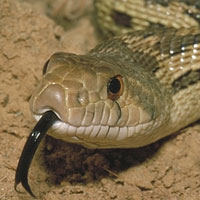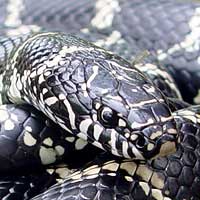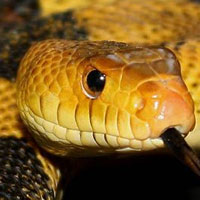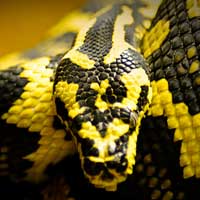Caring for the Fascinating Trinket Rat Snake
The Trinket Rat Snake, scientifically known as Coelognathus helena, belongs to the Colubridae family, which is the largest family of snakes, comprising a wide variety of non-venomous and mildly venomous species recognized for their adaptability and diverse habitats across the globe.
Scientific Name: Coelognathus helena
Snake Family: Colubridae
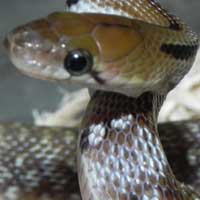
Introduction to the Trinket Rat Snake
The Trinket Rat Snake (*Coelognathus helena*) is a non-venomous snake native to the Indian subcontinent and parts of Southeast Asia. Known for its slender body and striking yellow-and-brown banded pattern, this snake is admired by reptile enthusiasts for its beauty and relatively easy care requirements. The Trinket Rat Snake is an excellent choice for those looking to keep a manageable and visually captivating pet snake.
Designing an Ideal Habitat for the Trinket Rat Snake
Creating a habitat that mimics the Trinket Rat Snake’s natural environment is crucial for its health and well-being. These snakes are often found in forests, grasslands, and agricultural fields. Consider the following when setting up their enclosure:
- Enclosure Size: A minimum of a 30-gallon tank for juveniles, with a 40-gallon or larger tank for adults.
- Temperature Gradient: Maintain daytime temperatures of 75-85°F with a basking spot at 90°F, and nighttime temperatures of 65-75°F.
- Humidity: Keep humidity levels between 50-70%, achieved through misting and a water dish.
- Substrate: Use coconut husk, cypress mulch, or aspen shavings to mimic their natural ground cover.
- Enrichment: Provide climbing branches, rocks, and hides to encourage exploration and natural behaviors.
Below is a quick reference table for setting up the habitat:
| Habitat Element | Specifications |
|---|---|
| Enclosure Size | 30-40 gallons |
| Temperature | 75-85°F (day), 65-75°F (night) |
| Humidity | 50-70% |
| Substrate | Coconut husk, cypress mulch, aspen shavings |
Feeding Your Trinket Rat Snake: What You Need to Know
The Trinket Rat Snake is a carnivorous species with a straightforward diet in captivity. Here’s how to feed them:
- Juveniles: Offer pinky mice every 5-7 days.
- Subadults: Provide small to medium-sized mice every 7-10 days.
- Adults: Feed adult mice or small rats every 10-14 days.
- Prey Type: Use pre-killed prey to ensure safe and stress-free feeding.
- Hydration: Ensure a fresh water supply is always available in a shallow dish.
Establishing a consistent feeding schedule is key to maintaining your snake’s health and vitality.
Behavior and Temperament of the Trinket Rat Snake
The Trinket Rat Snake is known for its active and curious nature, making it an engaging pet. Key behavioral traits include:
- Activity Level: These snakes are primarily diurnal, being most active during the day.
- Climbing Enthusiasts: They enjoy climbing, so vertical space and sturdy branches are essential.
- Temperament: While generally calm, they may exhibit defensive behaviors, such as hissing or bluffing, when stressed.
- Stress Indicators: Frequent hiding, refusal to eat, or erratic behavior may indicate stress or unsuitable conditions.
Providing an enriched and secure environment reduces stress and ensures your snake thrives in captivity.
Health and Lifespan of the Trinket Rat Snake
With proper care, the Trinket Rat Snake can live 15-20 years in captivity. Key health considerations include:
- Common Health Issues: Respiratory infections, improper shedding, and mite infestations are the most common concerns.
- Preventative Measures: Maintain stable environmental conditions and clean the enclosure regularly.
- Veterinary Care: Schedule regular check-ups with an exotic animal veterinarian to monitor their health.
- Observation: Watch for signs of illness, such as lethargy, loss of appetite, or unusual behaviors.
Proactive care and a well-maintained habitat ensure a long and healthy life for your snake.
Reproduction and Breeding of the Trinket Rat Snake
Breeding Trinket Rat Snakes in captivity can be a rewarding experience. Key factors to consider include:
- Breeding Season: Typically occurs in spring after a winter brumation period.
- Clutch Size: Females lay 5-10 eggs per clutch.
- Incubation: Eggs should be incubated at 80-85°F for 50-60 days.
- Hatchling Care: Provide appropriately sized enclosures and prey for juveniles.
Proper preparation and monitoring are essential for successful breeding and healthy offspring.
Tips for Handling and Caring for the Trinket Rat Snake
Proper handling and care are vital to building trust and ensuring the health of your Trinket Rat Snake. Follow these tips:
- Handle the snake gently, supporting its entire body to minimize stress.
- Avoid handling immediately after feeding to prevent regurgitation.
- Keep the enclosure clean and provide enrichment to encourage natural behaviors.
- Monitor their health regularly and address any signs of stress or illness promptly.
- Establish a routine for feeding, cleaning, and interaction to create a positive environment.
With proper care and attention, the Trinket Rat Snake can become a rewarding and low-maintenance pet.
Other Snakes In This Species
 Aesculapian Rat Snake
Aesculapian Rat Snake Amur Russian Rat Snake
Amur Russian Rat Snake Bairds Rat Snake
Bairds Rat Snake Black Rat Snake
Black Rat Snake Chinese Twin-spotted Rat Snake
Chinese Twin-spotted Rat Snake Diadem Rat Snake
Diadem Rat Snake Diones Rat Snake
Diones Rat Snake Eastern Fox Snake
Eastern Fox Snake Everglades Rat Snake
Everglades Rat Snake Four-lined Rat Snake
Four-lined Rat Snake Gray Rat Snake
Gray Rat Snake Great Plains Rat Snake
Great Plains Rat Snake Green Rat Snake
Green Rat Snake Ladder Rat Snake
Ladder Rat Snake Leopard Rat Snake
Leopard Rat Snake Mandarin Rat Snake
Mandarin Rat Snake Radiated Rat Snake
Radiated Rat Snake Steppes Rat Snake
Steppes Rat Snake Texas Rat Snake
Texas Rat Snake Trans-Pecos Rat Snake
Trans-Pecos Rat Snake Trinket Rat Snake
Trinket Rat Snake Yellow Rat Snake
Yellow Rat Snake



